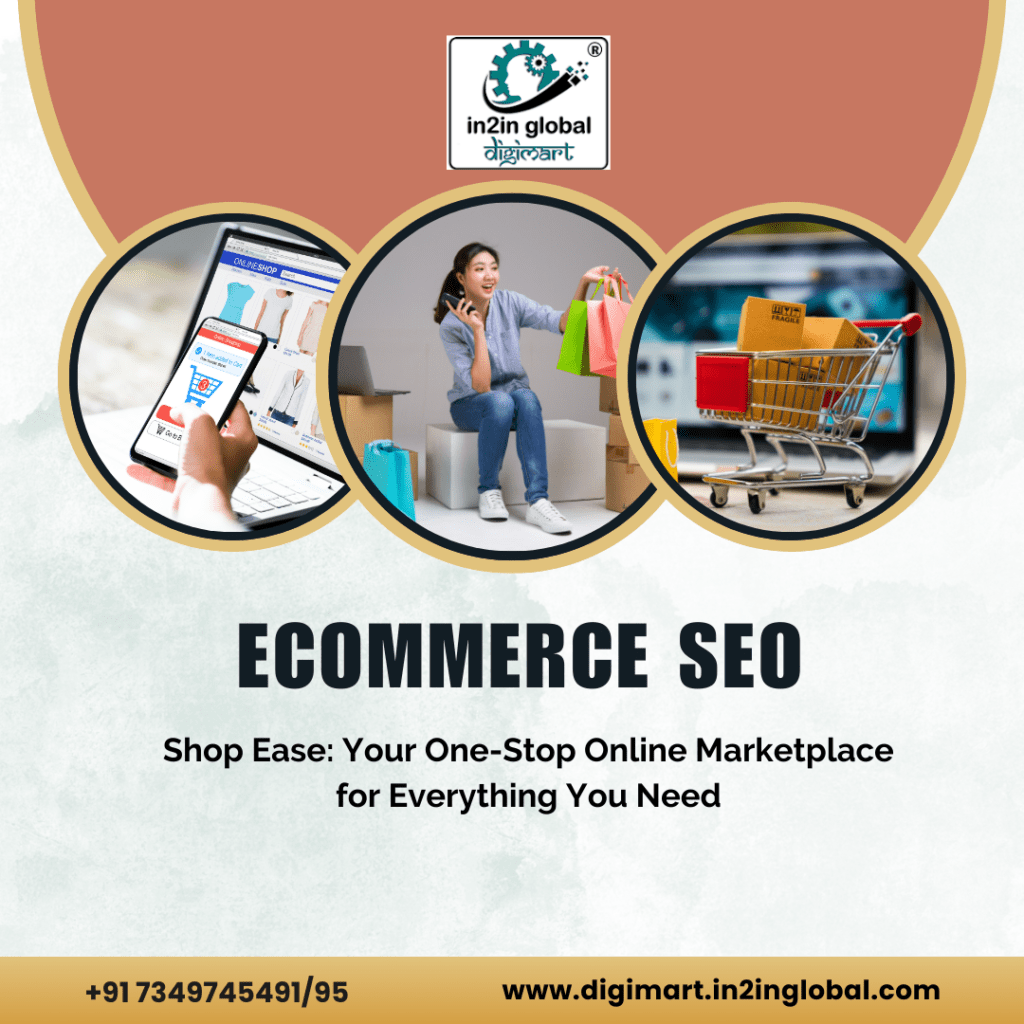
24, Jun 2024
The Ultimate Guide to E-commerce SEO Strategies in 2024
In the fast-paced world of online shopping, it’s greater essential than ever to stand out from the competition. Ensuring E-commerce SEO (Search Engine Optimization) is fundamental to making sure your on-line keep ranks high in search engine results, visitors, and converts visitors into loyal customers. In this comprehensive guide, we’ll delve into the strategies and best practices that will help you optimize your e-commerce site for SEO, making sure that your services and products are determined by your target audience.

Understanding E-commerce SEO
E-commerce SEO entails optimizing your on-line shop to rank better in search engine effects pages (SERPs). This consists of converting your website’s architecture, product descriptions, metadata, and more. The purpose is to generate greater organic visitors from engines like google, Bing, and Yahoo, ultimately increasing income and sales.
What is SEO in E-commerce?
E-commerce SEO includes optimizing online shops to rank first in search engine result. This increases visibility, will increase organic traffic, targets the right keywords, improves site structure, provides precious content that suits user wishes and search engine pointers and it increases sales.
Why is E-commerce SEO Important?
- Increased Visibility: Higher rankings on SERPs mean more visibility for your online store. When your web site seems on the first page of search outcomes, it is much more likely to be clicked on through potential customers
- Cost-Effective Marketing: Unlike paid advertising, SEO focuses on organic search results. While it calls for an initial funding of time and resources, the long-time period benefits of sustained traffic make it a cost-powerful advertising method.
- Enhanced User Experience: SEO isn’t just about search engines; it’s also about providing a better user experience. A nicely-optimized site is faster, less complicated to navigate, and more person-friendly, that may lead to higher conversion quotes.
Key Components of E-Commerce SEO
To effectively optimize your e-commerce site, you’ll need to focus on several key components:
1. Keyword Research in E-Commerce SEO
Keyword research is the integral part of any success SEO method. It includes figuring out the hunt phrases your capacity customers are the use of to locate merchandise much like yours. Tools like Google Keyword Planner, Ahrefs, and SEMrush assist you to find out relevant key phrases with excessively seek volume and occasional competition.
Tips for Effective Keyword Research
- Focus on Long-Tail Keywords: Long-tail key phrases are more particular terms that capacity clients are in all likelihood to use when they’re toward making a purchase. For instance, instead of focused on “jogging shoes,” you may target “best strolling footwear for flat ft.”
- Analyze Competitors: Look at the keywords your competitors are targeting. This can provide valuable insights into which keywords are using traffic on your area of interest.
- Consider User Intent: Understand the intent behind the keywords. Are users looking for information, or are they ready to buy? Target keywords that align with the different stages of the buyer’s journey.
2. SEO works in E-Commerce SEO
a) On-Page SEO
On-page SEO includes optimizing individual pages in your internet site to acquire higher scores and generate relevant site visitors. The foremost features are:
- Title Tags: Create catchy and keyword-rich identify tags for each page. This is the primary element customers see of their search consequences.
- Meta Descriptions: Write an informative and attractive meta description that encourages customers to visit your web site.
- Header Tags: Use header tags (H1, H2, H3) and encompass applicable keywords.
- Product Descriptions: Write unique, special, and keyworded product descriptions. Avoid duplicates, as search engines penalize websites for this.
- Image exceptional: Use outstanding pictures and optimize them with descriptive document names and alt textual content with suitable key phrases.
- URL Structure: Product Descriptions: Write unique, special, and keyworded product descriptions. Avoid duplicates, as search engines penalize websites for this.
- Image exceptional: Use outstanding pictures and optimize them with descriptive document names and alt textual content with suitable key phrases.
b) Technical SEO
Technical search engine marketing ensures that search engines can locate and index your website online efficiently. Key features include:
- Site Speed: A fast-loading site improves user experience and is favored by search engines. Use tools like Google Page Speed Insights to become aware of and connect pace problems.
- Mobile Optimization: Ensure your site is mobile-friendly. With the increasing use of smartphones for on line buying, a cell-optimized internet site is vital.
- Secure Website (HTTPS): Security is a rating thing for Google. Make positive your net web site makes use of HTTPS to protect individual records.
- XML Sitemap: Create and put up an XML sitemap to assist engines like google recognize your internet website’s layout and discover all your pages.
- Robots.txt: Use the robots. Txt report to coach search engine crawlers which pages to index and which to disregard.
3. Content Marketing in E-Commerce SEO
Content marketing plays a vital role in e-commerce SEO. By developing treasured and attractive content material, you could entice and retain a definitely defined audience. This no longer only drives visitors but additionally builds brand authority and agree with.
Types of Content to Consider in E-Commerce SEO
- Blog Posts: Write informative blog posts that address common questions and pain points of your target audience. Include relevant keywords and internal links to your product pages.
- Buying Guides: Create comprehensive buying guides that help customers make informed purchasing decisions. These guides can rank well for long-tail keywords and drive targeted traffic.
- Product Reviews and Testimonials: Encourage satisfied customers to leave reviews and testimonials. Positive reviews can improve your site’s credibility and attract more customers.
- Videos: Produce product demonstration videos, tutorials, and customer testimonials. Video content is highly engaging and can improve your site’s SEO.
4. Link Building in E-Commerce SEO
Link building is the process of acquiring high-quality backlinks from other websites to your own. Backlinks are an important ranking factor, as they signal to search engines that your site is trustworthy and authoritative.
Effective Link Building Strategies
- Guest Blogging: Write guest posts for reputable blogs in your industry. Include links back to your site in your author bio or within the content where appropriate.
- Influencer Collaborations: Partner with influencers in your niche to promote your products. Influencers can provide valuable backlinks and drive traffic to your site.
- Content Outreach: Reach out to websites and blogs that might find your content valuable. Share your blog posts, guides, and infographics to earn backlinks.
- Broken Link Building: Identify broken links on other websites and offer your content as a replacement. This helps the website owner fix their broken links while providing you with a backlink.
5. User Experience (UX) and Conversion Rate Optimization (CRO) in E-Commerce SEO
A seamless user experience and effective conversion rate optimization go hand in hand with SEO. When traffic has a high-quality revel in on your site, they are much more likely to transform into clients.
Tips for Enhancing UX and CRO
- Easy Navigation: Ensure your site is easy to navigate with clear categories, filters, and search functionality.
- Clear Call-to-Actions (CTAs): Use compelling and strategically placed CTAs to guide users towards making a purchase.
- Trust Signals: Display trust signals such as secure payment icons, customer reviews, and money-back guarantees to build trust with potential buyers.
- Optimized Checkout Process: Streamline the checkout process to reduce cart abandonment. Minimize the wide variety of steps and offer a couple of charge alternatives.
6. Monitoring and Analytics for E-Commerce SEO
To make sure your e-commerce SEO efforts are paying off, it is essential to show your site’s overall performance and make statistics-pushed decisions. Tools like Google Analytics, Google Search Console, and SEMrush can provide precious insights into your internet site’s web site traffic, man or woman behavior, and key-word scores.
Key Metrics to Track
- Organic Traffic: Monitor the number of visitors coming to your site from organic search results.
- Bounce Rate: Track the percentage of visitors who leave your site after viewing only one page. A high bounce rate may indicate that your site isn’t meeting user expectations.
- Conversion Rate: Measure the percentage of visitors who complete a desired action, such as making a purchase or signing up for a newsletter.
- Keyword Rankings: Keep an eye on your keyword rankings to see how well your site is performing in search results.
- Backlinks: Monitor the number and quality of backlinks pointing to your site.
Conclusion:
Optimizing your E-commerce site for SEO is a multi-faceted method that requires constant attempt and interest. By that specialize in keyword studies, on-page and technical search engine marketing, content material marketing, link constructing, and person experience, you can enhance your website’s visibility, generate greater natural site visitors, and boom sales
Start using these E-commerce SEO techniques today and watch your on-line shop rise to the peak of search engine outcomes, entice greater customers and growth your income. Contact us to make your E-commerce SEO.
- 0
- By info






